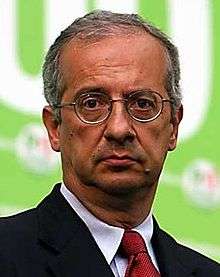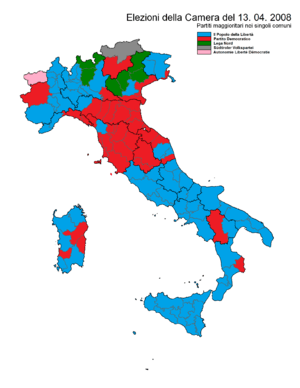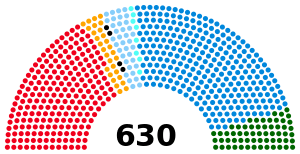Italian general election, 2008
| | |||||||||||||||||||||||||||||||||||||||||||||||||||||||||||||||||||
| |||||||||||||||||||||||||||||||||||||||||||||||||||||||||||||||||||
| |||||||||||||||||||||||||||||||||||||||||||||||||||||||||||||||||||
|
| |||||||||||||||||||||||||||||||||||||||||||||||||||||||||||||||||||
| Legislative election results map. Azure denotes provinces with a People of Freedom plurality, Red denotes those with a Democratic plurality, Green denotes those with a Lega Nord plurality, Pink and Gray denotes those with a Regionalist plurality. | |||||||||||||||||||||||||||||||||||||||||||||||||||||||||||||||||||
| |||||||||||||||||||||||||||||||||||||||||||||||||||||||||||||||||||
A snap general election was held in Italy on 13–14 April 2008.[1] The election came after President Giorgio Napolitano dissolved Parliament on 6 February 2008, following the defeat of the government of Prime Minister Romano Prodi in a January 2008 Senate vote[2] and the unsuccessful tentative appointment of Franco Marini with the aim to change the current electoral law. Under Italian law, elections must be held within 70 days of the dissolution. The voting determined the leader of Italy's 62nd government since the end of World War II.[3] The coalition led by ex-Prime Minister Silvio Berlusconi from The People of Freedom party defeated that of former Mayor of Rome, Walter Veltroni of the Democratic Party.[4]
Electoral system
Italians voted in this election with the same electoral system used in 2006, based on party-list representation. This electoral system allows parties to formally define coalitions. The coalition with a plurality of votes nationwide then obtains an absolute majority of seats in the Chamber of Deputies. Similarly, absolute majorities of Senate seats are awarded regionally.
General election
Background
On 24 January 2008 Prime Minister of Italy Romano Prodi lost a vote of confidence in the Senate by a vote of 161 to 156 votes, causing the downfall of his government.[5] Prodi's resignation led President Giorgio Napolitano to request the president of the Senate, Franco Marini, to assess the possibility to form a caretaker government. The other possibility would have been to call for early elections immediately.
The decision of former Minister of Justice Mastella arrived a few days after the confirmation of the Constitutional Court which confirmed the referendum to modify the electoral system.[6] As stated many times by Minister Mastella, if the referendum would have been confirmed this would have led directly to the fall of the government[7][8]
and it happened.
The fall of the government would disrupt a pending election-law referendum that if passed would make it harder for small parties like Mastella's to gain seats in parliament.[9]
UDEUR's defection forced the question of whether Prodi still had the parliamentarian support to govern. Presenting a motion of confidence to parliament, he won relatively easily in the lower house of the Parliament, the Chamber of Deputies, where the coalition's majority was substantial.[10] Yet a win in the upper house – or Senate – seemed unlikely, and President Giorgio Napolitano was said to have warned against going through with the vote.[10]
The vote, held between 3pm and 9pm (CET), was heated and dramatic.[11] During its course the UDEUR party Senator Stefano Cusumano decided to confirm the confidence and to support the prime minister, even against the orders of his party's leader. He was subsequently subjected to the abuse of his colleagues, being called an "hysteric faggot", "traitor", and reportedly spat on by a member of the conservative UDEUR party. At this point Cusumano apparently fainted, and was carried out on a stretcher.[12] Cusumano's defection had no effect, however: Prodi lost the vote with 161 to 156 votes (one member abstained from voting, while three were absent), and promptly handed in his resignation.[11]
On 30 January, Napolitano appointed Franco Marini to try to form a caretaker government with the goal of changing the current electoral system, rather than call a quick election.[13] The state of the electoral system had been under criticism not only within the outgoing government, but also among the opposition and in the general population, because of the impossibility to choose candidates directly and of the risks that a close-call election may not grant a stable majority in the Senate.
On 4 February 2008 Marini acknowledged that he had failed to find the necessary majority for an interim government,[14] and resigned his mandate,[15] after having met with all major political forces and having found opposition to forming an interim government mainly from center-right parties Forza Italia and National Alliance, favoured in a possible next election and strongly in favour of an early vote.,[16]
President Napolitano summoned Bertinotti and Marini, the two speakers of the houses of the Italian parliament, acknowledging the end of the legislature, on 5 February 2008.[17] He dissolved parliament on 6 February 2008.
Campaign
Major competitors in the election were Silvio Berlusconi, as leader of the centre-right opposition coalition, and Walter Veltroni, leader of the Democratic Party. Berlusconi's right coalition was leading by a significant margin in opinion polls.[18] The 71-year-old Berlusconi, who was twice prime minister—from May 1994 to January 1995 and again from May 2001 to May 2006—was not considered too old for the job though he had had heart surgery since leaving office.[19]
Veltroni's campaign has been compared to Barack Obama's presidential run in the United States. The most apparent of the similarities is his slogan, "Si può fare" (literally, "it can be done").[19]
Following the calling of the election, Veltroni stated his party will not make any alliance in either Chamber, choosing instead to run alone with its own platform, and challenged Berlusconi to do likewise with his Forza Italia party. The main four left-wing parties not part of the PD decided to contest the election together under the banner of The Left – The Rainbow. On 8 February, Berlusconi announced Forza Italia and Gianfranco Fini's National Alliance will run together under the common symbol of The People of Freedom, being regionally allied with Lega Nord.[20]
On 13 February, Veltroni announced to have reached an agreement with the Italy of Values, led by Antonio Di Pietro, which agreed for an electoral alliance with the Democratic Party, accepting also to join the Democratic Party parliamentary groups after the election.[21] On 21 February the Italian Radicals announced an agreement with the Democratic Party, accepting to present themselves in list with the latter, under the agreement they will have nine MPs elected in the Parliament, and appointment of Emma Bonino as Minister in case of victory.[22]
Though Berlusconi and Veltroni were in opposite parties, they allegedly represent such similar policies that they were dubbed "Veltrusconi". Both candidates supported big tax cuts and generous spending programs.[19]
The Union of Christian and Centre Democrats was invited to support Berlusconi, but refused and decided to run on its own instead. The Rose for Italy originally planned to run alone with Bruno Tabacci as their PM candidate, but shortly before the filing deadline, they decided to form joint lists with the UDC.
Parties and leaders
Coalitions and electoral list
| Political force or alliance | Constituent lists | Leader | ||
|---|---|---|---|---|
| (Coalizione di centrodestra) |
The People of Freedom (Il Popolo della Libertà) | | ||
| Northern League (Lega Nord) | ||||
| Movement for Autonomy (Movimento per l'Autonomia) | ||||
| (Coalizione di centrosinistra) |
Democratic Party (Partito Democratico) | | ||
| Italy of Values (Italia dei Valori) | ||||
| (Unione di Centro) |
Union of the Centre (Unione di Centro) | | ||
| (La Sinistra – L'Arcobaleno) |
Communist Refoundation Party (Rifondazione Comunista) | | ||
| Party of Italian Communists (Partito dei Comunisti Italiani) | ||||
| Federation of the Greens (Federazione dei Verdi) | ||||
| Democratic Left (Sinistra Democratica) | ||||
| (La Destra – Fiamma Tricolore) |
The Right – Tricolour Flame (La Destra – Fiamma Tricolore) | | ||
- Leaders
Results for the Chamber of Deputies
Italy (19 regions out of 20)
Aosta Valley
| Party | % | Votes | Seats | |
|---|---|---|---|---|
| Autonomy Liberty Democracy | 39.12 | 29,314 | 1 | |
| Aosta Valley (UV-SA-FA) | 37.84 | 28,357 | 0 | |
| The People of Freedom | 18.52 | 13,880 | 0 | |
| Lega Nord | 3.10 | 2,322 | 0 | |
| Social Action | 1.42 | 1,066 | 0 | |
| Total | 100.00 | 74,939 | 1 | |
Italians abroad
| Party | % | Votes | Seats | |
|---|---|---|---|---|
| Democratic Party | 32.48 | 338,954 | 6 | |
| The People of Freedom | 30.90 | 322,437 | 4 | |
| Union of the Centre | 8.43 | 88,017 | 0 | |
| Associative Movement Italians Abroad | 8.33 | 86,970 | 1 | |
| Italian Associations in South America | 6.16 | 64,325 | 0 | |
| Italy of Values | 4.04 | 42,149 | 0 | |
| Socialist Party | 3.12 | 32,513 | 0 | |
| The Left - The Rainbow | 2.73 | 28,495 | 0 | |
| The Right-Tricolour Flame | 1.43 | 14,974 | 0 | |
| The Other Sicily | 0.89 | 9,251 | 0 | |
| Critical Left | 0.58 | 6,062 | 0 | |
| Italian Civic Consumers | 0.47 | 4,878 | 0 | |
| Values and Future | 0.43 | 4,493 | 0 | |
| Total | 100.00 | 1,043,518 | 12 | |
Overall result
Popular vote and parliamentary seats in the Chamber of Deputies.
Results for the Senate of the Republic
Italy (18 regions out of 20)
Aosta Valley
| Party | % | Votes | Seats | |
|---|---|---|---|---|
| Aosta Valley (UV-SA-FA) | 41.39 | 29,191 | 1 | |
| Autonomy Liberty Democracy | 37.40 | 26,377 | 0 | |
| The People of Freedom | 17.25 | 12,167 | 0 | |
| Lega Nord | 2.95 | 2,081 | 0 | |
| Social Action | 1.01 | 712 | 0 | |
| Total | 100.00 | 70,520 | 1 | |
Trentino-Alto Adige/South Tyrol
| Party | % | Votes | Seats | |
|---|---|---|---|---|
| The People of Freedom | 28.18 | 156,126 | 3 | |
| South Tyrolean People's Party - Together for the Autonomies | 27.75 | 153,721 | 2 | |
| South Tyrolean People's Party | 17.86 | 98,948 | 2 | |
| The Left - The Rainbow | 7.21 | 39,957 | 0 | |
| Union of the Centre | 5.87 | 32,511 | 0 | |
| Die Freiheitlichen | 4.47 | 24,772 | 0 | |
| Democratic Party | 3.48 | 19,253 | 6 | |
| The Right-Tricolour Flame | 2.97 | 16,462 | 0 | |
| Union for South Tyrol | 2.13 | 11,820 | 0 | |
| Socialist Party | 0.07 | 369 | 0 | |
| Total | 100.00 | 553,939 | 7 | |
Italians abroad
| Party | % | Votes | Seats | |
|---|---|---|---|---|
| The People of Freedom | 33.86 | 322,698 | 3 | |
| Democratic Party | 33.02 | 314,703 | 2 | |
| Associative Movement Italians Abroad | 7.61 | 72,511 | 1 | |
| Italian Associations in South America | 6.38 | 60,794 | 0 | |
| Union of the Centre | 6.07 | 57,817 | 0 | |
| Italy of Values | 4.02 | 38,357 | 0 | |
| Socialist Party | 2.95 | 28,149 | 0 | |
| The Left - The Rainbow | 2.84 | 27,067 | 0 | |
| The Right-Tricolour Flame | 1.38 | 13,139 | 0 | |
| The Other Sicily | 0.88 | 8,391 | 0 | |
| Critical Left | 0.61 | 5,855 | 0 | |
| Italian Civic Consumers | 0.38 | 3,663 | 0 | |
| Total | 100.00 | 953,144 | 6 | |
Overall result
Popular vote and parliamentary seats in the Senate.
See also
References
- ↑ "Italy's President Dissolves Parliament, Forces Vote". Bloomberg.com. 6 February 2008. Retrieved 8 February 2008.
- ↑ "Italy to hold snap April election". BBC News. 6 February 2008. Retrieved 6 February 2008.
- ↑ "Berlusconi plans Naples clean-up". BBC News. 15 April 2008.
- ↑ "Berlusconi declares election win". BBC News. 14 April 2008.
- ↑ "Prodi loses crucial Senate vote". BBC. 2008-01-24. Archived from the original on 27 January 2008. Retrieved 2008-01-24.
- ↑ "Italian court okays referendum on election law" Reuters, January 16th 2008
- ↑ "Legge elettorale, Mastella minaccia la crisi" Corriere della Sera, April 10, 2007
- ↑ "Mastella: Se c'è referendum si rischia la crisi di governo" La Stampa, April 10, 2007
- ↑ "Prodi Likely to Quit, Prompt Vote or Election Reform" Bloomberg.com
- 1 2 Ian Fisher (2008-01-24). "Italy Backs Its Coalition but Only Just for Now". New York Times. Archived from the original on 27 January 2008. Retrieved 2008-01-24.
- 1 2 "Prodi sconfitto in Senato: cade il governo, Il premier al Quirinale per le dimissioni" (in Italian). Corriere della Sera. 2008-01-24. Archived from the original on 25 January 2008. Retrieved 2008-01-24.
- ↑ "Cusumano si dissocia: voto sì. È bagarre" (in Italian). Corriere della Sera. 2008-01-24. Archived from the original on 27 January 2008. Retrieved 2008-01-24.
- ↑ "Crisi, Napolitano incarica Marini" (in Italian). Corriere della Sera. 2008-01-30. Archived from the original on 31 January 2008. Retrieved 2008-01-30.
- ↑ SignOnSanDiego.com > News > World - Italy Senate speaker fails to form govt, vote looms
- ↑ Italy's Marini says no majority for electoral reform govt, resigns mandate | Latest News | News | Hemscott
- ↑ ""A Marini diremo: "subito al voto""" (in Italian). Corriere della Sera. 2008-01-30. Archived from the original on 3 February 2008. Retrieved 2008-01-30.
- ↑ "DOMANI LO SCIOGLIMENTO DELLE CAMERE" (in Italian). Ansa. 2008-02-05. Archived from the original on 2008-02-04. Retrieved 2008-02-05.
- ↑ Elisabeth Rosenthal (7 February 2008). "With Flawed System Unchanged, Italy Sets Elections for April". The New York Times. Retrieved 8 February 2008.
- 1 2 3 "Italy faces second day of voting". CNN. 14 April 2008. Archived from the original on 15 April 2008. Retrieved 14 April 2008.
- ↑ "Berlusconi: "Simbolo unico per Fi e An"". Corriere della Sera (in Italian). 8 February 2008. Retrieved 8 February 2008.
- ↑ "Pd: accordo Di Pietro, Veltroni" (in Italian). ANSA.it. 13 February 2008. Retrieved 21 February 2008.
- ↑ "I Radicali dicono sì al Pd: 9 seggi e Bonino ministro". L'Unità (in Italian). 21 February 2008. Retrieved 21 February 2008.
External links
- NSD: European Election Database - Italy publishes regional level election data
| ||||||||||||||||||||||||||







